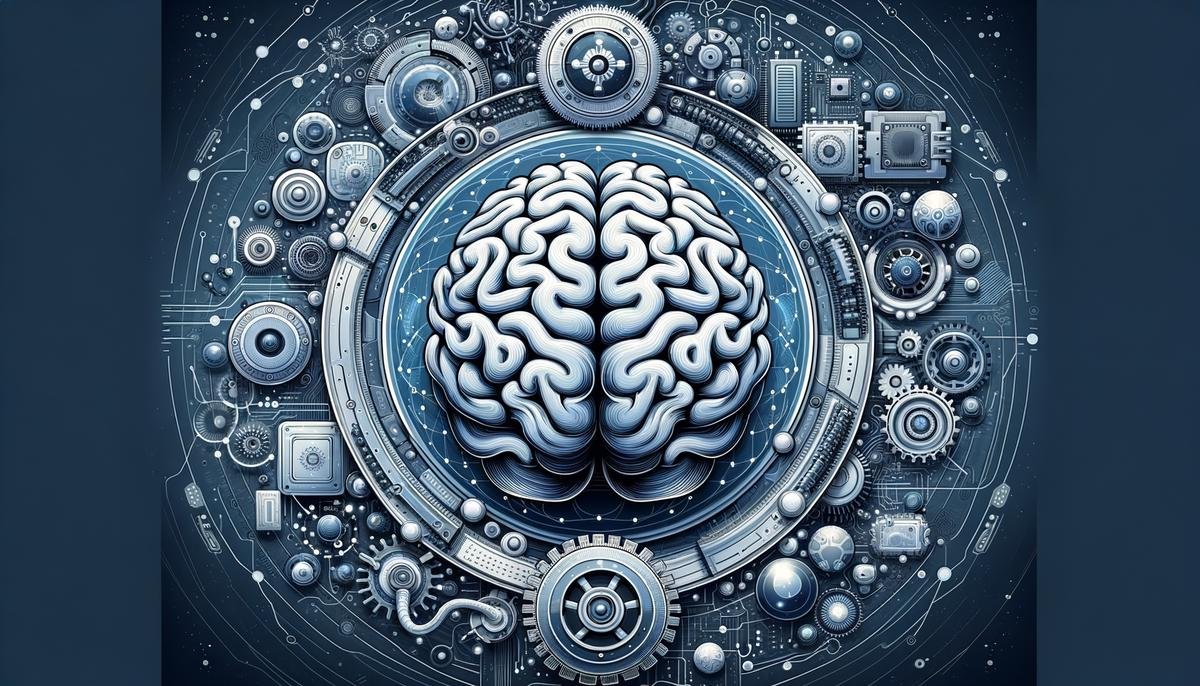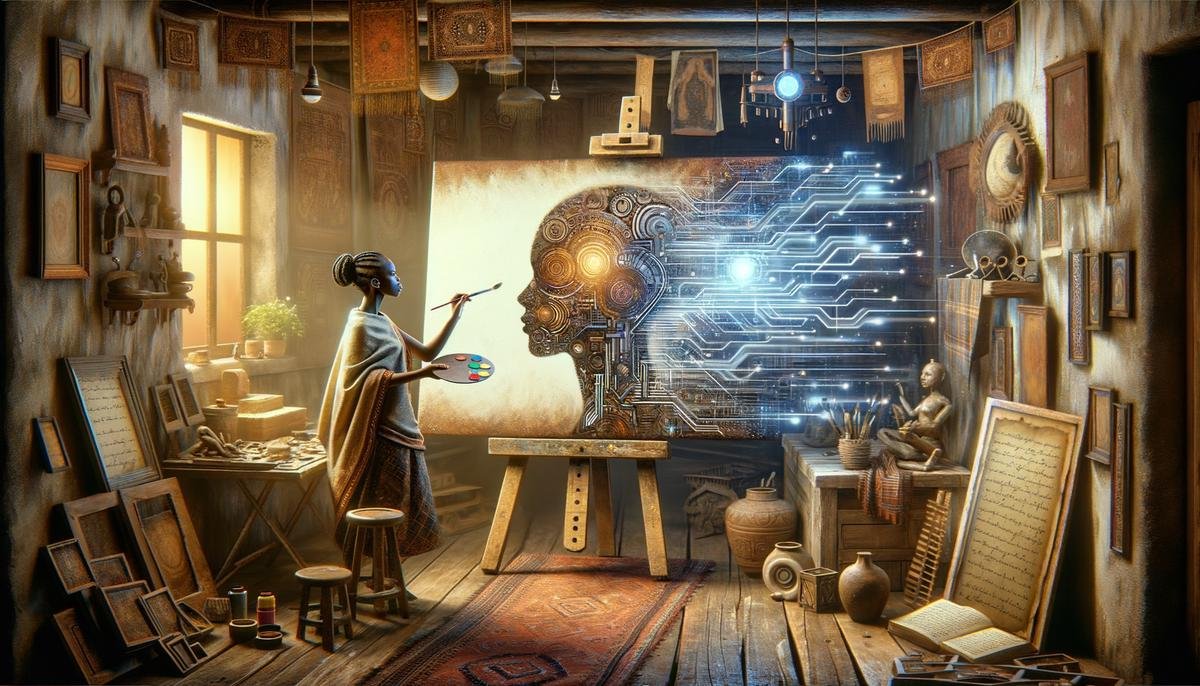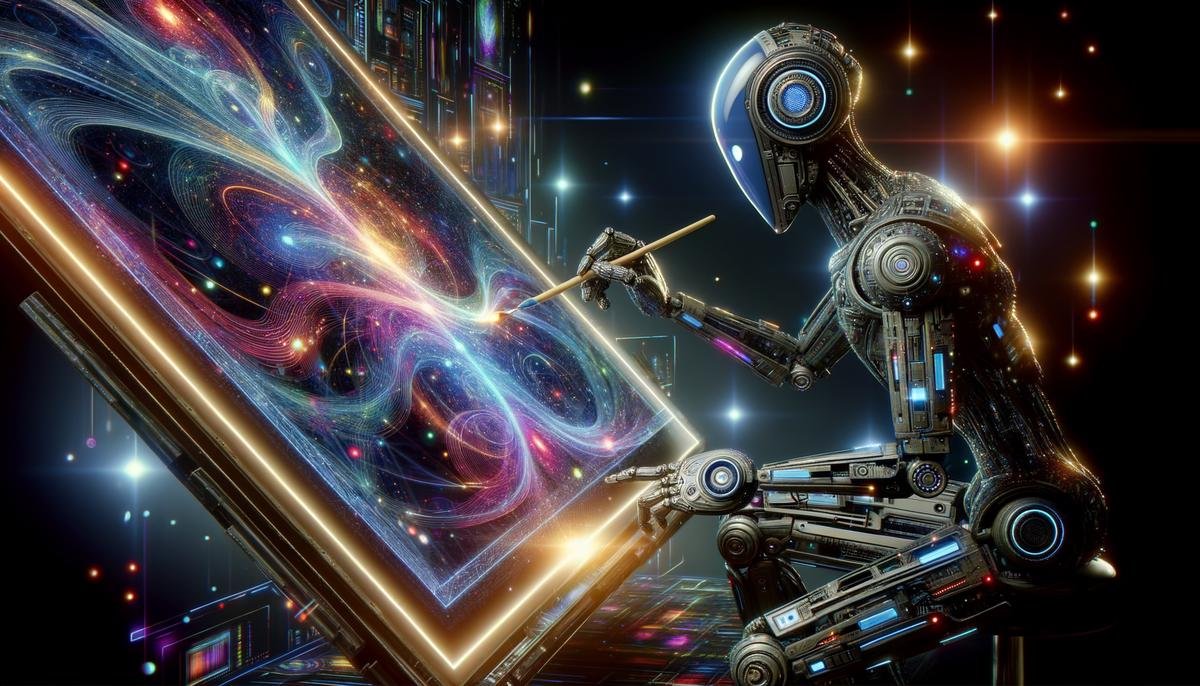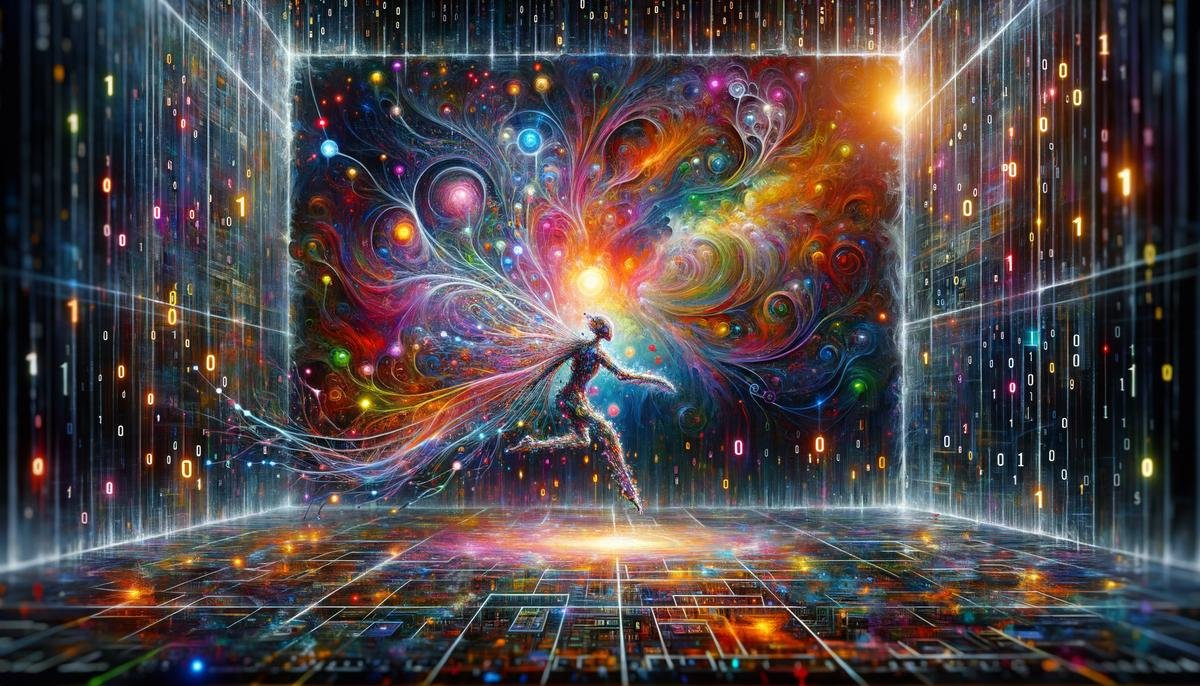Artificial General Intelligence, or AGI, is quickly becoming a key player in the world of art and creativity. This exciting technology is expanding what’s possible in creativity, pushing us to explore beyond traditional boundaries. By harnessing the power of AGI, we’re entering a new phase where the blending of technology and human creativity could redefine what it means to create. This article takes a closer look at how AGI is influencing creativity, the opportunities it presents, and the challenges we might face as it becomes more integrated into the artistic process.
Understanding AGI in the Realm of Creativity
Unlocking the Power of AGI in Creativity
Have you ever heard about AGI and wondered what it’s all about? AGI stands for Artificial General Intelligence, and it’s a game-changer in the world of creativity. Unlike traditional AI, which focuses on specific tasks, AGI has the ability to understand, learn, and apply knowledge across a wide range of activities, just like a human brain. Let’s dive into how AGI is making waves in creativity and why it’s something to get excited about.
At the heart of AGI is its versatility. Picture this: an AI that can write a poem, compose a piece of music, and even brainstorm marketing strategies for your next big project. AGI isn’t limited to one skill; it’s like having a jack-of-all-trades in your digital toolbox. This level of flexibility is ushering in a new era where technology and creativity merge in ways we’ve only dreamed of.
One of the standout features of AGI is its problem-solving capability. Creative fields often require thinking outside the box, and AGI excels at coming up with innovative solutions. Whether it’s finding a unique angle for a story or experimenting with unconventional art styles, AGI can push the boundaries of creativity, offering fresh perspectives that might not be immediately obvious to the human mind.
But how does AGI do this? It all boils down to its learning process. Unlike standard AI, which operates within predefined parameters, AGI uses a more holistic approach. It draws on a vast pool of information, learning from different domains to apply knowledge in new and creative ways. This ability to cross-pollinate ideas from various fields is what makes AGI such a powerful tool for creative projects.
Collaboration is another area where AGI shines. Imagine working alongside an AGI system to bring your creative visions to life. This technology can serve as a partner, offering suggestions, simulating outcomes, and even taking on tasks to free up your time for more complex creative decisions. The potential for synergy between human creativity and AGI’s capabilities is staggering.
Now, you might wonder, is AGI going to replace human creativity? Not quite. The goal of AGI is to enhance and expand our creative possibilities. By taking care of repetitive or time-consuming tasks, AGI allows us to focus on the heart and soul of creative work—the human touch. It’s about amplifying our creative potential, not substituting it.
AGI is revolutionizing creativity by breaking down conventional barriers and opening up a world of possibilities. From bolstering the creative process to fostering innovative collaborations, the impact of AGI is profound. As we continue to explore the capabilities of AGI, one thing is clear: the future of creativity is bright, and it’s being shaped by the incredible advances in artificial general intelligence. Whether you’re an artist, writer, or entrepreneur, AGI is a tool that holds the promise to propel your creative endeavors to new heights.

The Impact of AGI on Traditional Artistic Roles
Harnessing AGI to Revolutionize the Artistic Process
Diving into the realm of artistic creation, Artificial General Intelligence (AGI) is quickly becoming a cornerstone for innovation, offering artists and creators a dazzling array of opportunities to push the boundaries of their craft. The relationship between AGI and creativity is spawning a new era where technology and artistry meet, leading to unprecedented growth and transformation within creative industries.
One striking transformation induced by AGI is the democratization of artistic creation. Traditionally, certain forms of art required specialized skills or costly resources, limiting access for many aspiring creators. However, AGI levels the playing field, offering tools and platforms that simplify complex tasks. For instance, AGI-powered software can now assist in composing music, generating digital artwork, or even writing scripts, making these artistic endeavors more accessible to a broader audience. This shift not only amplifies diversity in creative outputs but also empowers individuals to explore their creative potential without the barrier of mastering intricate techniques.
Moreover, AGI is redefining the concept of artistic collaboration. Creators are no longer confined to human-only collaborations; they can now partner with AGI to explore new creative territories. This partnership enables artists to input initial ideas or themes, with AGI then offering variations or continuations, effectively becoming a muse that never tires. Such collaborations can lead to novel creations that may not have been conceivable through human effort alone. This synergy between human creativity and AGI’s computational power nudges artists to experiment beyond traditional boundaries, fostering a culture of innovation and experimental art.
Additionally, AGI’s impact extends to streamlining the creative workflow. The grunt work often associated with creative projects, such as editing or sorting through data, can be offloaded to AGI, freeing artists to focus on the more nuanced aspects of their work. This not only enhances productivity but also ensures that creative energies are directed towards innovation and expression rather than menial tasks.
Challenges and ethical considerations also come into play with the advent of AGI in creative fields. Issues such as copyright and originality surface, raising questions about the ownership of AI-generated content. The unique nature of AGI-driven creation necessitates a reevaluation of existing legal frameworks to ensure that creativity is nurtured while protecting the rights and interests of human artists.
Furthermore, AGI could potentially disrupt traditional roles in the creative industry, prompting a need for new skill sets and adaptability among artists and creators. Embracing this change, individuals can leverage AGI as a tool to enhance their capabilities rather than viewing it as a replacement, leading to a co-evolution of human and machine creativity.
In conclusion, AGI is not just altering the landscape for artists and creators; it’s propelling it into a new dimension. From democratizing access to art creation and fostering unique collaborations to streamlining processes and challenging conventional norms, AGI’s imprint on the creative world is profound. As we march into the future, the fusion of AGI and human creativity heralds a promising horizon, ripe with possibilities for exploration, innovation, and above all, a richer tapestry of artistic expression. The journey of artistic creation, aided by AGI, is only just beginning, promising a wild ride into the unknown realms of creativity.

Ethical Considerations in AI-Generated Art
Alright, let’s dive into the heart of the matter – the ethical quandaries that swirl around the use of AGI, or Artificial General Intelligence, in the realm of art. This tech breakthrough is like nothing we’ve seen, with the potential to turn the entire artistic landscape on its head. But with great power comes great responsibility, right? So, let’s unpack this.
First up, credit where credit’s due – or rather, the headache of figuring out who gets the credit when an AGI is involved. Imagine this: an AGI whips up a stunning piece of artwork, or crafts a hit song that climbs the charts. Who takes the bow? The programmer behind the AGI? The AGI itself? And let’s not even get started on copyright issues. The waters are murky here, friends, and we’re just starting to navigate them.
Then there’s the question of authenticity and originality. Art is about expression, a splash of the human soul on canvas, in music, or through words. But when an AGI creates art, what are we experiencing? Can a program have a soulful outpouring? Does the art it produces carry the same weight, or are we looking at a shiny form of artistic counterfeit?
On a similar note, think about the impact on artists themselves. With AGIs capable of churning out masterpieces, what’s to become of the human artist? There’s fear in the air that AGIs might not just complement artists but could replace them altogether. The thought alone sends shivers down the spine – a world where human artistry takes a backseat to algorithms and machine learning.
Moreover, consider the accessibility of AGI technology. It’s not cheap, and not everyone can get their hands on it. This raises a flag about inequality in the artistic domain. Could we be heading towards a future where only those with the means to harness AGI get to shape our cultural landscapes? That’s a chilling prospect, highlighting a potential divide between the ‘haves’ and ‘have-nots’ in art.
And it’s not just about economics. There’s a cultural dimension to ponder as well. With AGIs capable of producing art that resonates with wide audiences, could we see a homogenization of culture? A world where local nuances and diverse artistic expressions are smoothed over by AGI-created content designed to appeal to the masses? The loss of cultural diversity in art would be a tragedy, diluting the richness that different perspectives bring to the table.
Lastly, let’s touch on emotional manipulation. Art evokes feelings – it makes us laugh, cry, think, and feel. But what if AGIs learn to master this, creating art so tailored to our psychological profiles that it manipulates our emotions? The ethical implications are vast, veering into dystopian territory where our feelings are not our own but are engineered by lines of code.
So, there you have it – a canvas of ethical dilemmas painted by the advent of AGI-driven art. It’s a brave new world out there, full of potential but also fraught with questions that demand our attention. As we move forward, navigating these waters with care will be crucial to ensure that the future of art remains vibrant, diverse, and distinctly human.

Future Trends: AGI and the Evolution of Artistic Creativity
Now, let’s dive into an area ripe with potential and curiosity: the blend of AGI (Artificial General Intelligence) with human ingenuity in the realm of creativity. Imagine a canvas where the brushstrokes are guided not just by the human hand but also by the intelligent whispers of AGI. This fusion promises to redefine the boundaries of what’s creatively possible, offering a kaleidoscope of opportunities and challenges that we are just beginning to understand.
One emerging trend is the evolution of personalized art experiences. With AGI’s capacity to process and analyze vast amounts of data, it can craft artistic pieces that resonate on a deeply personal level with individuals. Picture a piece of music that can adapt its rhythm and melodies to match your mood swings, thanks to AGI’s interpretive prowess. Or a digital mural in your living room that shifts its colors and patterns in sync with the changing seasons outside your window. The future of art crafted by AGI promises an unparalleled level of personal connection and emotional resonance.
AGI’s role in education and skill development in creative fields is another area set to transform. Traditional learning paths often involve years of study and practice to master a craft, be it painting, composing music, or writing novels. AGI could dramatically shorten this learning curve, offering personalized tutorials and adaptive learning materials that respond to a student’s progress and challenges. It could also simulate different artistic styles, providing a sandbox for students to explore and learn from the masters without the pressure of irreversible mistakes. As AGI becomes more integrated into education, we may see a surge in creative talent blossoming at a younger age, enriched by early and intimate encounters with diverse artistic expressions.
The trend of immersive and interactive art experiences powered by AGI cannot be overlooked. Imagine stepping into a narrative that unfolds based on your choices, where the story’s characters, environment, and plot twist react dynamically to your actions. This isn’t the choose-your-own-adventure books of yesteryear but a multidimensional storytelling experience that blurs the lines between creator and audience. AGI could enable these interactive narratives to evolve over time, offering a living story that grows with and around its audience. Such experiences could redefine engagement in artistic expression, transforming passive observation into active participation.
However, with these exciting possibilities come challenges that need to be navigated carefully. As AGI takes on a more prominent role in creative endeavors, discussions about authenticity and human essence in art become paramount. Can a piece of art that touches the soul be considered authentic if an AGI played a hand in its creation? This question opens up a Pandora’s box of philosophical debate about the nature of creativity and the essence of human touch in art.
Moreover, the democratization of creativity through AGI tools raises questions about the dilution of artistic skill and talent. When powerful AGI-driven tools are at everyone’s fingertips, the line between amateur and professional could blur, challenging traditional hierarchies within the art world. While this democratization can usher in a renaissance of creative expression, it also demands a reevaluation of what it means to be an artist in the age of AGI.
In conclusion, the intersection of AGI and creativity is poised to usher in a new era of artistic expression, where the limits are bound only by our imagination. As we stand on this precipice, looking out at the burgeoning landscape of possibilities, it’s clear that the future of creativity and art will be a thrilling fusion of human intuition and AGI innovation. The canvas of the future awaits, ready to be painted with the vibrant hues of this groundbreaking partnership.

As we explore the vast potential of Artificial General Intelligence in the realm of art and creativity, it’s evident that AGI is more than just a tool; it’s a collaborator that can unlock new levels of creative expression. The future of art and creativity, enriched by AGI, promises a landscape where human imagination and artificial intelligence coalesce to bring forth unprecedented artistic endeavors. While challenges remain, particularly in ethics and authenticity, the promise of AGI in enhancing and expanding our creative horizons is undeniably compelling. The canvas of tomorrow will be painted not only with the strokes of human artists but with the intricate algorithms of AGI, bringing to life visions yet unimagined. The exploration of AGI in creativity is not just about what technology can do for us, but also about how it can inspire us to reimagine the boundaries of our own potential.



